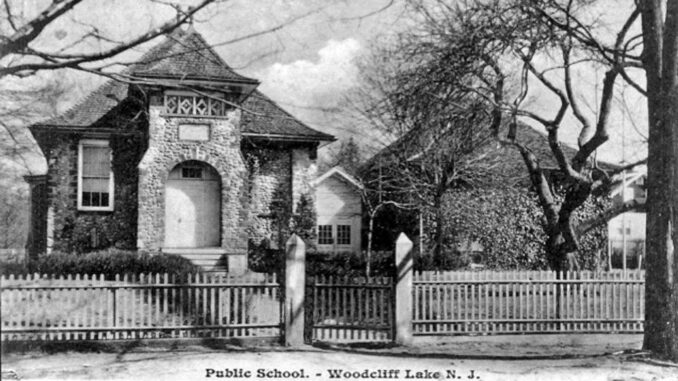
WOODCLIFF LAKE—Last week we featured the old St. Paul’s Episcopal Church in Montvale, sometimes called the Old Stone Church, designed in 1895 by Woodcliff architect Samuel Burrage Reed. With school fast approaching—sorry, kids!—this week we turn to Reed’s other big Pascack Valley project, the Woodcliff schoolhouse.
(See “Mayor’s wife, town marshal square off at the church,” Back in Time, Pascack Press, Aug. 22, 2022.)
Situated on Woodcliff Avenue in the midst of the modern Woodcliff Middle School campus, the little stone schoolhouse is a reminder of education in the old days. It’s the oldest continually operating school building in Bergen County, having opened on Sept. 9, 1895.
After the Borough of Woodcliff broke off from Washington Township to incorporate in 1894, the first local board of education meeting soon followed. There was an important matter at hand: securing a piece of land upon which to build the borough’s very own schoolhouse. Resident G.M. Fairchild came through with an offer to donate a parcel of land to the community.
The building’s design came courtesy of Samuel B. Reed, a nationally known architect who had just recently been elected the borough’s first mayor. Reed’s own home served as the venue for the first borough meetings.
With offices based in New York City, Reed was the architect behind prominent buildings in New Jersey, New York and Connecticut—including the Passaic County Courthouse, Middle Collegiate Church on Second Avenue in New York City, and more. Born in Meriden, Connecticut, in 1834 and trained as a carpenter in his teen years, Reed went to New York City at age 21 to take up the profession of architect. He had a successful career for more than 40 years.

While Reed’s office was in the city, his estate was in the quiet countryside at Woodcliff. His notable Pascack Valley works—the schoolhouse in Woodcliff and St. Paul’s in neighboring Montvale, both date to 1895. At one time, Reed was also the president of the board of education in Woodcliff.
The Woodcliff schoolhouse cost less than $2,500 to build. It had one classroom that contained 26 student desks, three chairs, and a desk for the teacher. Miss Fannie M. Casine was the first teacher, and she received an annual salary of $60.
The school building was often rented out to local organizations in order to raise money for necessities. The school’s second teacher, Mr. H. L. Terry, took over in 1897 and started a library fund. In the 1898–1899 school year, families raised $24.13 toward the fund, and this, coupled with a $20 grant from the state, enabled the purchase of a bookcase that became the school’s library.
By 1900 there were 329 people living in Woodcliff. Of these, 83 were school-age children, 5–16. Still, only about 40 kids attended school on any given day. Those were days before compulsory attendance laws, when during certain seasons chores around the farm took precedence over the three Rs.
For $2,500 the Woodcliff Lake community has certainly gotten their money’s worth. The schoolhouse, like the Old Stone Church, has stood for nearly 130 years as the modern world developed around it. These structures exemplify the old adage: “They don’t build them like that anymore!”
— Krisitn Beuscher, a former editor of Pascack Press, is president of Pascack Historical Society in Park Ridge and edits its quarterly newsletter, Relics.
